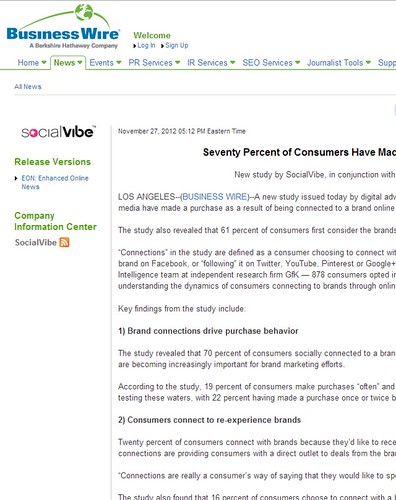 News on Social Marketing, according to eMarketer : Social media platforms have basically changed the way that companies and their customers interact. But on a study conducted by Pitney Bowes Software last September, it shows that adult internet users and marketing decision-makers in the US, the UK, France, Germany and Australia should make sure they are not over committing to social channels, and, that their actions on social media are aligned with consumer preferences.
News on Social Marketing, according to eMarketer : Social media platforms have basically changed the way that companies and their customers interact. But on a study conducted by Pitney Bowes Software last September, it shows that adult internet users and marketing decision-makers in the US, the UK, France, Germany and Australia should make sure they are not over committing to social channels, and, that their actions on social media are aligned with consumer preferences.
The study reveals certain differences of consumers concentration on certain social media networks, compared to the percentage of marketers on those channels. For the 5 five countries being polled, those making marketing decisions responded to the adoption of Facebook, although, the number of marketers on a given platform outpaced the potential customers there, in many other cases.
For example, 57% of marketers reported using Twitter compared with 31% of consumers. On Google+, 51% of marketers used the site with 21% of consumers using it, while only 41% of marketers had established a presence on YouTube with 53% of consumers had their presence on the site.
While internet users were more likely to be found on YouTube over Twitter, marketers have a more heavy presence on the microblog network vs. the digital video channel, compared.
Another important thing that marketers need to keep in mind as to why they should approach social marketing more cautiously is the consumer’s lack of interests on marketing messages that are pushed at them on social media.
Consumers who saw ads from brands they followed has an annoyance rate of 11% while a 24% increase was observed for those confronted with social media marketing messages from brands they didn’t follow.
Read more at Campaigns should align with customer preferences
 News on Social Marketing, according to Marketing Pilgrim : With the slowing down of the online holiday rush, people are now looking for a way to give back at this time of year.
News on Social Marketing, according to Marketing Pilgrim : With the slowing down of the online holiday rush, people are now looking for a way to give back at this time of year.
There are many ways we can get involved by helping raise funds for school supplies for children in need or by volunteering to feed the homeless. The Corporation for National & Community Service’s serve.gov site is the best place to start if you want to help. Helping a non-profit organization on a different level is also an option for those with specific expertise.
Sparked, identifies itself as the world’s first micro volunteering network, or “volunteerism for the digital age.” These non profit organizations may express their needs through the website – from blogging to copywriting to SEO and more. Then, depending on their availability and their willingness to participate, volunteers with the right skills and interests are then matched to those needs.
Volunteer Match, a nonprofit-volunteer matching organization, help matches volunteers with opportunities. Like for example, a search for ‘marketing’ volunteer opportunities in Orlando, FL yields 21 results, from the Arthritis Foundation’s Jingle Bell Run/Walk to StandUp for Kids.
Another nonprofit organization is HandsOn Network. It focuses on skills-based volunteering, which essentially means connecting the right volunteer with the right project. It says that over 30 million volunteer hours was being mobilized last year which valued at more than $626 million.
Even for the busiest digital marketer, the commitment to help non profit organizations is manageable as most of these challenges take only a few hours to complete. Media Cause limits its focus to nonprofit needs in the area of Google Grants, social media, and SEO.
Read more at 4 Great Ways Marketers Can Give Back This Season
 News on Social Marketing, according to Business Wire : SocialVibe, a digital advertising technology company, reveals on its recent study that 70% of consumers actively engaged in social media, whether on Twitter, Pinterest, Google+, YouTube or Facebook have made a purchase as a result of being connected to a brand online. It also shows that when consumers are shopping, the brands they are connected with are first considered by 61% of respondents.
News on Social Marketing, according to Business Wire : SocialVibe, a digital advertising technology company, reveals on its recent study that 70% of consumers actively engaged in social media, whether on Twitter, Pinterest, Google+, YouTube or Facebook have made a purchase as a result of being connected to a brand online. It also shows that when consumers are shopping, the brands they are connected with are first considered by 61% of respondents.
The study, conducted by the Digital Marketing Intelligence team at independent research firm GfK , aimed at better understanding the dynamics of consumers connecting to brands through online social channels. Opting to take a survey across SocialVibe’s network of premium partner sites are 878 respondents.
The study defined connections as a consumer choosing to connect with a brand online through an action such as “following” it on Twitter, YouTube, Pinterest or Google+ or “liking” the brand on Facebook.
Social connections are becoming increasingly important for brand marketing efforts as revealed by the study. It shows that a purchase has been made by 70% of consumers socially connected to a brand online where 19 percent make purchases “often”, 29% make purchases “sometimes” and 22% having made a purchase once or twice because of a brand connection.
The study also shows that consumers connect to re-experience brands with 20% of respondents saying that that they want to repurchase with an offer or discount. Sixteen percent of consumers choose to connect with a brand because they want to know about the brand’s latest news and information.
According to the study, once connected, consumers regularly stay in touch with 23% of consumers’ checking back weekly for updates on the brands they’re connected to and 17% on a daily basis.
However, results of the study also shows that connections have to be carefully preserved as 37% of consumers who create these online social connections with brands also end them by un-liking or un-following. One-third of consumers who stop connecting from brands did so because they were receiving too many updates.
Read more at Seventy Percent of Consumers Have Made a Purchase as a Result of Being Connected to a Brand Online
Other Social Marketing Articles of Interest
Future of luxury brand augmented reality: Wow to utility
